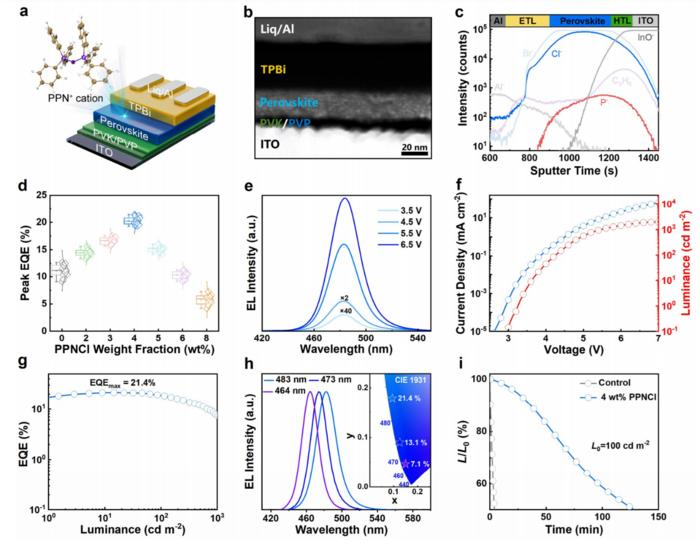Reviewed by Lexie CornerMar 18 2024
Professor Linsong Cui's research team, affiliated with the University of Science and Technology of China (USTC), collaborated with Professor Samuel D. Stranks' team from the University of Cambridge to develop an innovative approach aimed at improving the performance of blue light-emitting diodes (LEDs) utilizing perovskite materials. Their work was published in the journal Nature Photonics.
 Perovskite LED device structure and performance. Image Credit: Professor Cui’s team
Perovskite LED device structure and performance. Image Credit: Professor Cui’s team
Perovskite LEDs have become a promising next-generation lighting and display technology because of their excellent luminescence and affordability. Blue perovskite LED development has lagged, creating a major bottleneck in the field despite notable advancements in green, red, and near-infrared perovskite LEDs.
To address this challenge, the research team created Bis(triphenylphosphine)iminium chloride (PPNCl), a multifunctional ionic additive with multiple charged resonance forms and a dynamic electronic state.
The efficiency and stability of blue perovskite LEDs are significantly increased by this compound, facilitating the control of the composition and distribution of perovskite phases. It also effectively suppresses non-radiative recombination channels and ion migration.
Through hydrogen bonding interactions, PPNCl influences the crystallization process and promotes the transition to high-dimensional phases with increased luminescence efficiency in the perovskite.
Studies using transient absorption (TA) spectroscopy also showed that PPNCl suppresses incomplete energy transfer and energy loss from non-radiative recombination in low-dimensional phases while accelerating energy transfer processes from low-dimensional to high-dimensional phases.
PPNCl molecules also exhibit electrostatic interactions and coordinate with the perovskite components to passivate defects in perovskite films and prevent halide ion migration. This results in a notable improvement in the luminescence efficiency and spectral stability of perovskite films.
The study team achieved stable and high-efficiency blue perovskite LEDs because of the effective control PPNCl has over ion migration, defect states, and perovskite phase distribution. With an emission peak at 483 nm, these devices display the highest peak external quantum efficiency (EQE) of any blue perovskite LED to date, 21.4 %. There has also been a nearly 30-fold improvement in the devices' stability.
This ground-breaking accomplishment signals significant progress in perovskite LED technology and opens the door for future improvements in blue perovskite LED performance.
Journal Reference:
Yuan, S., et al. (2024) Efficient blue electroluminescence from reduced-dimensional perovskites. Nature Photonic. doi.org/10.1038/s41566-024-01382-6